Economic Analysis of the AUD/USD Exchange Rate and Factors
VerifiedAdded on 2021/04/24
|13
|2892
|34
Report
AI Summary
This report provides an economic analysis of the AUD/USD exchange rate, examining its determinants within the Foreign Exchange (Forex) market. It utilizes a demand and supply framework to explain fluctuations, considering factors like inflation, interest rates, and growth rates. The report further explores nominal exchange rates, Trade Weighted Index (TWI), and their fluctuations over a three-year period, highlighting the influence of the US dollar and commodity prices. It also discusses the impact of AUD depreciation on imports and exports, along with potential government interventions to manage the exchange rate, such as export promotion and interest rate adjustments, while acknowledging potential side effects of these measures.

Running head: ECONOMIC FOR PROFESSIONALS
Economic for professionals
Name of the student
Name of the University
Author note
Economic for professionals
Name of the student
Name of the University
Author note
Paraphrase This Document
Need a fresh take? Get an instant paraphrase of this document with our AI Paraphraser

1ECONOMIC FOR PROFESSIONALS
Table of Contents
Answer a:.........................................................................................................................................2
Answer b:.........................................................................................................................................4
Answer c:.........................................................................................................................................6
Answer d:.........................................................................................................................................8
Answer e:.........................................................................................................................................8
Reference:......................................................................................................................................11
Table of Contents
Answer a:.........................................................................................................................................2
Answer b:.........................................................................................................................................4
Answer c:.........................................................................................................................................6
Answer d:.........................................................................................................................................8
Answer e:.........................................................................................................................................8
Reference:......................................................................................................................................11
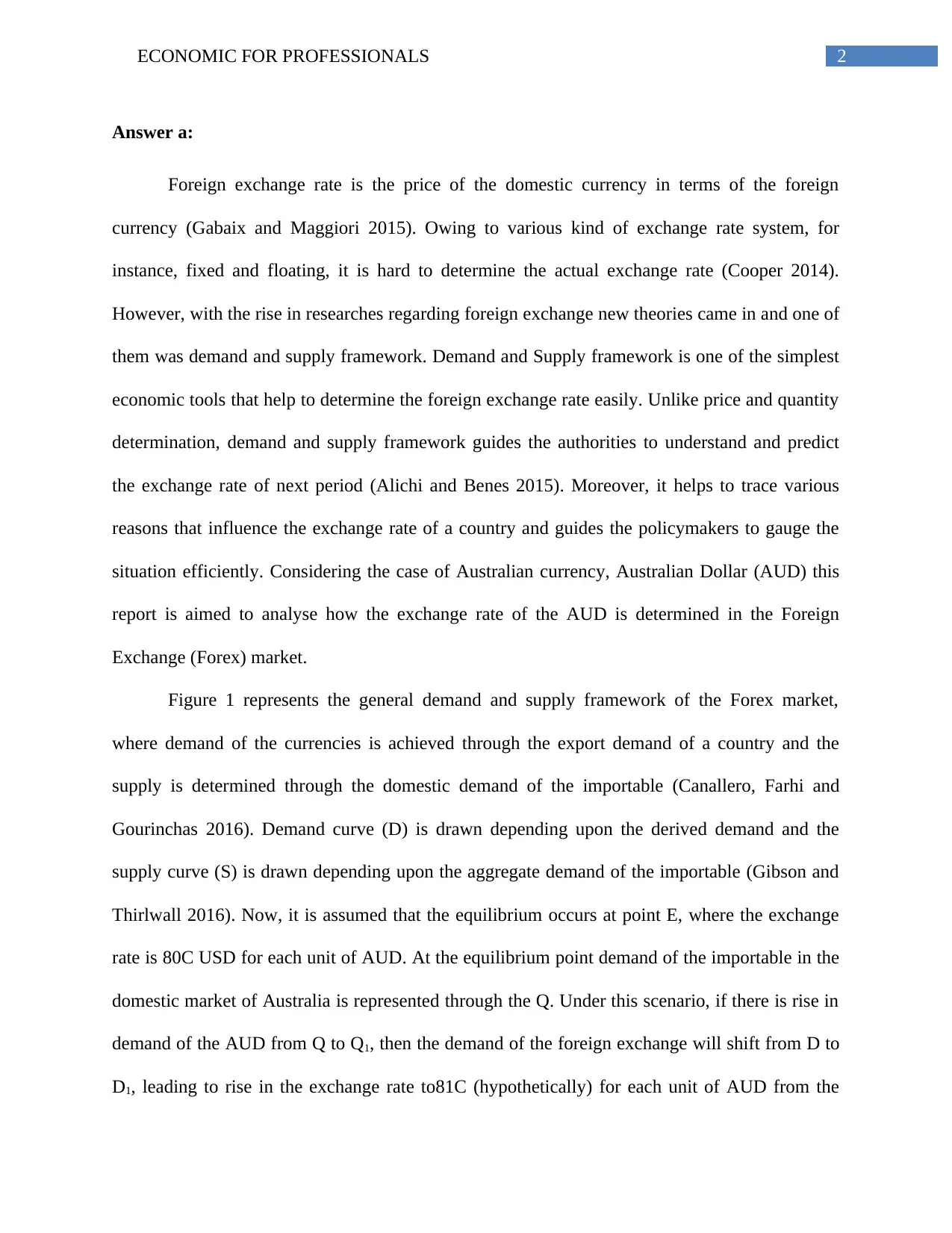
2ECONOMIC FOR PROFESSIONALS
Answer a:
Foreign exchange rate is the price of the domestic currency in terms of the foreign
currency (Gabaix and Maggiori 2015). Owing to various kind of exchange rate system, for
instance, fixed and floating, it is hard to determine the actual exchange rate (Cooper 2014).
However, with the rise in researches regarding foreign exchange new theories came in and one of
them was demand and supply framework. Demand and Supply framework is one of the simplest
economic tools that help to determine the foreign exchange rate easily. Unlike price and quantity
determination, demand and supply framework guides the authorities to understand and predict
the exchange rate of next period (Alichi and Benes 2015). Moreover, it helps to trace various
reasons that influence the exchange rate of a country and guides the policymakers to gauge the
situation efficiently. Considering the case of Australian currency, Australian Dollar (AUD) this
report is aimed to analyse how the exchange rate of the AUD is determined in the Foreign
Exchange (Forex) market.
Figure 1 represents the general demand and supply framework of the Forex market,
where demand of the currencies is achieved through the export demand of a country and the
supply is determined through the domestic demand of the importable (Canallero, Farhi and
Gourinchas 2016). Demand curve (D) is drawn depending upon the derived demand and the
supply curve (S) is drawn depending upon the aggregate demand of the importable (Gibson and
Thirlwall 2016). Now, it is assumed that the equilibrium occurs at point E, where the exchange
rate is 80C USD for each unit of AUD. At the equilibrium point demand of the importable in the
domestic market of Australia is represented through the Q. Under this scenario, if there is rise in
demand of the AUD from Q to Q1, then the demand of the foreign exchange will shift from D to
D1, leading to rise in the exchange rate to81C (hypothetically) for each unit of AUD from the
Answer a:
Foreign exchange rate is the price of the domestic currency in terms of the foreign
currency (Gabaix and Maggiori 2015). Owing to various kind of exchange rate system, for
instance, fixed and floating, it is hard to determine the actual exchange rate (Cooper 2014).
However, with the rise in researches regarding foreign exchange new theories came in and one of
them was demand and supply framework. Demand and Supply framework is one of the simplest
economic tools that help to determine the foreign exchange rate easily. Unlike price and quantity
determination, demand and supply framework guides the authorities to understand and predict
the exchange rate of next period (Alichi and Benes 2015). Moreover, it helps to trace various
reasons that influence the exchange rate of a country and guides the policymakers to gauge the
situation efficiently. Considering the case of Australian currency, Australian Dollar (AUD) this
report is aimed to analyse how the exchange rate of the AUD is determined in the Foreign
Exchange (Forex) market.
Figure 1 represents the general demand and supply framework of the Forex market,
where demand of the currencies is achieved through the export demand of a country and the
supply is determined through the domestic demand of the importable (Canallero, Farhi and
Gourinchas 2016). Demand curve (D) is drawn depending upon the derived demand and the
supply curve (S) is drawn depending upon the aggregate demand of the importable (Gibson and
Thirlwall 2016). Now, it is assumed that the equilibrium occurs at point E, where the exchange
rate is 80C USD for each unit of AUD. At the equilibrium point demand of the importable in the
domestic market of Australia is represented through the Q. Under this scenario, if there is rise in
demand of the AUD from Q to Q1, then the demand of the foreign exchange will shift from D to
D1, leading to rise in the exchange rate to81C (hypothetically) for each unit of AUD from the
⊘ This is a preview!⊘
Do you want full access?
Subscribe today to unlock all pages.

Trusted by 1+ million students worldwide
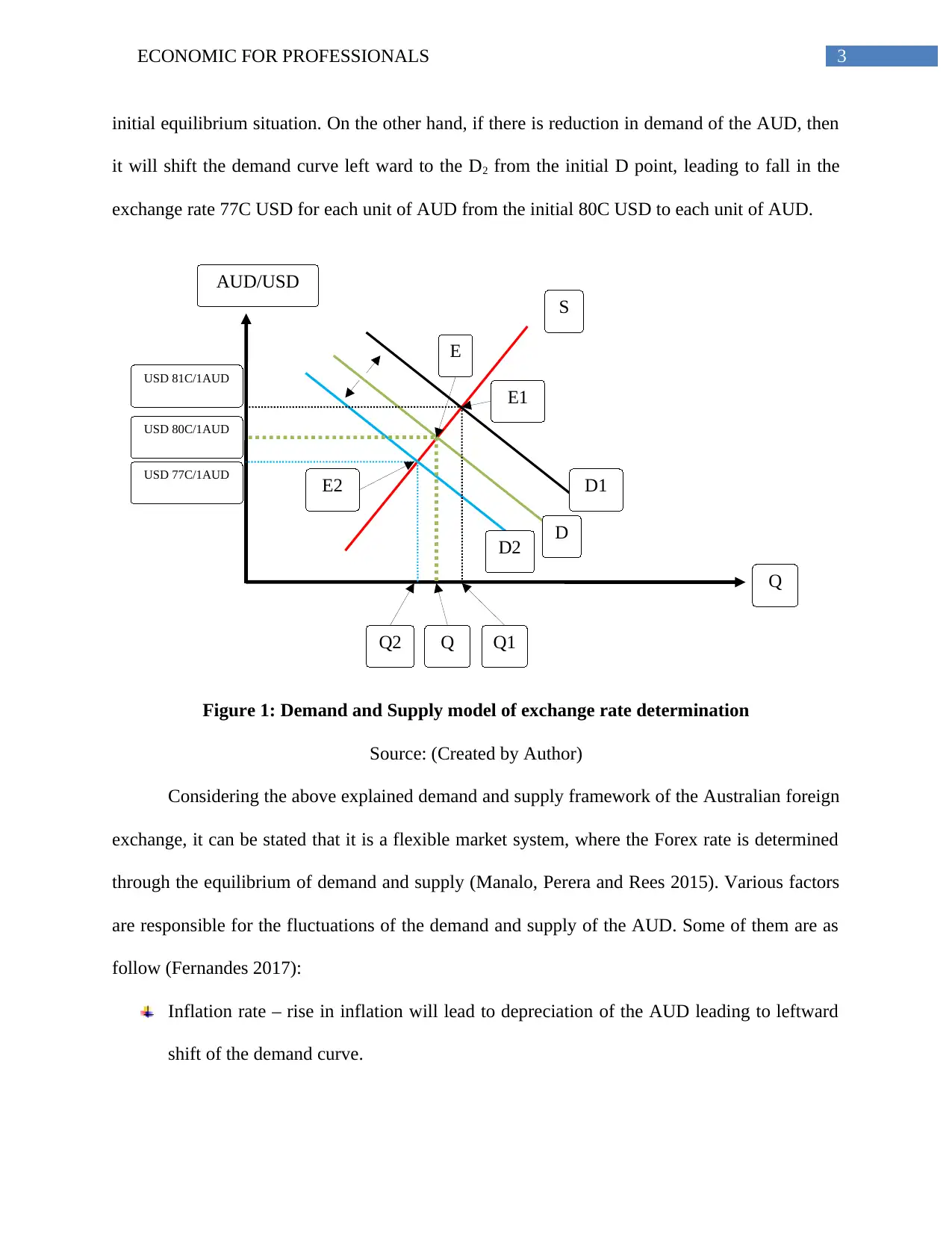
AUD/USD
S
D1
D
D2
Q
Q2 Q Q1
E1
E2
E
USD 80C/1AUD
USD 81C/1AUD
USD 77C/1AUD
3ECONOMIC FOR PROFESSIONALS
initial equilibrium situation. On the other hand, if there is reduction in demand of the AUD, then
it will shift the demand curve left ward to the D2 from the initial D point, leading to fall in the
exchange rate 77C USD for each unit of AUD from the initial 80C USD to each unit of AUD.
Figure 1: Demand and Supply model of exchange rate determination
Source: (Created by Author)
Considering the above explained demand and supply framework of the Australian foreign
exchange, it can be stated that it is a flexible market system, where the Forex rate is determined
through the equilibrium of demand and supply (Manalo, Perera and Rees 2015). Various factors
are responsible for the fluctuations of the demand and supply of the AUD. Some of them are as
follow (Fernandes 2017):
Inflation rate – rise in inflation will lead to depreciation of the AUD leading to leftward
shift of the demand curve.
S
D1
D
D2
Q
Q2 Q Q1
E1
E2
E
USD 80C/1AUD
USD 81C/1AUD
USD 77C/1AUD
3ECONOMIC FOR PROFESSIONALS
initial equilibrium situation. On the other hand, if there is reduction in demand of the AUD, then
it will shift the demand curve left ward to the D2 from the initial D point, leading to fall in the
exchange rate 77C USD for each unit of AUD from the initial 80C USD to each unit of AUD.
Figure 1: Demand and Supply model of exchange rate determination
Source: (Created by Author)
Considering the above explained demand and supply framework of the Australian foreign
exchange, it can be stated that it is a flexible market system, where the Forex rate is determined
through the equilibrium of demand and supply (Manalo, Perera and Rees 2015). Various factors
are responsible for the fluctuations of the demand and supply of the AUD. Some of them are as
follow (Fernandes 2017):
Inflation rate – rise in inflation will lead to depreciation of the AUD leading to leftward
shift of the demand curve.
Paraphrase This Document
Need a fresh take? Get an instant paraphrase of this document with our AI Paraphraser
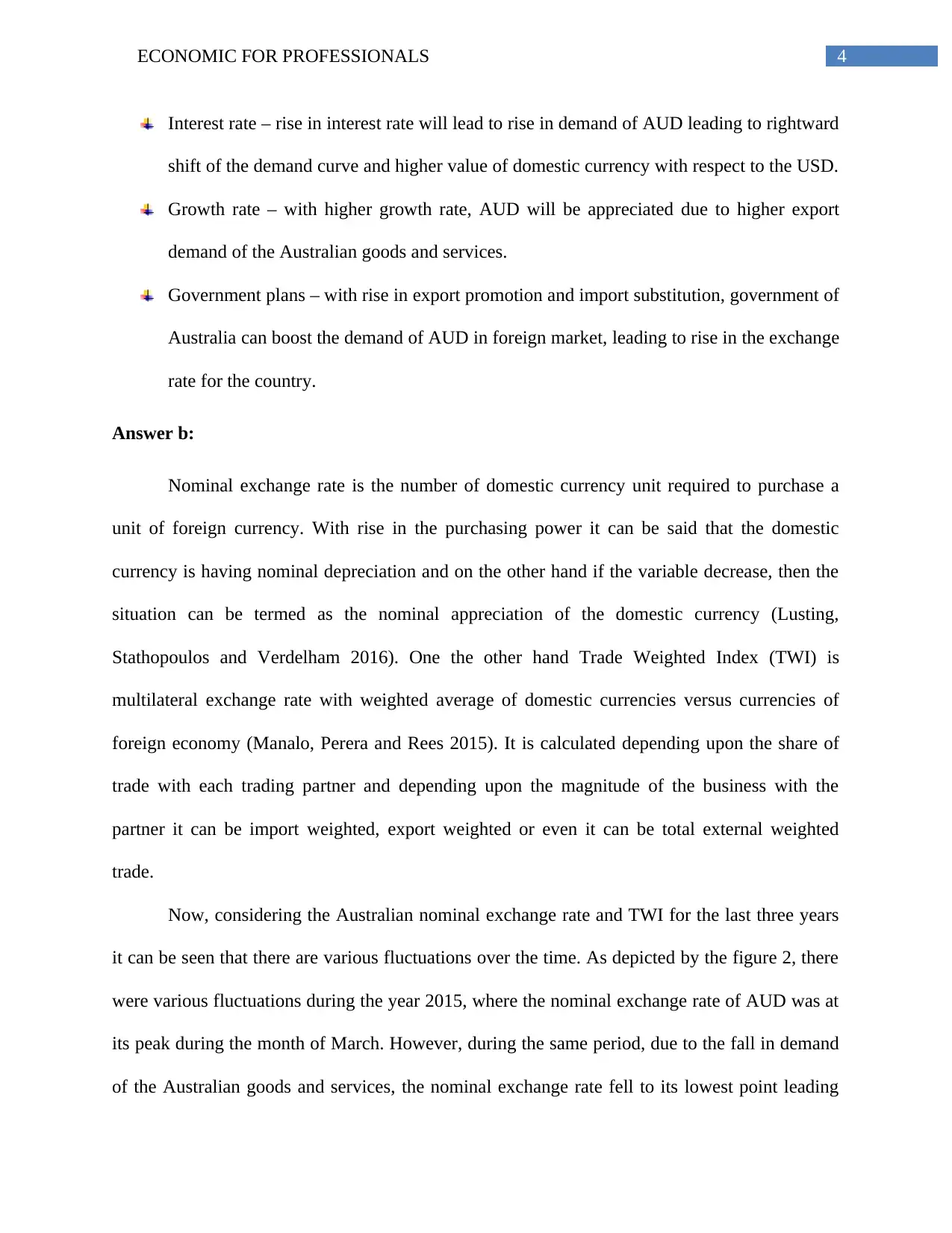
4ECONOMIC FOR PROFESSIONALS
Interest rate – rise in interest rate will lead to rise in demand of AUD leading to rightward
shift of the demand curve and higher value of domestic currency with respect to the USD.
Growth rate – with higher growth rate, AUD will be appreciated due to higher export
demand of the Australian goods and services.
Government plans – with rise in export promotion and import substitution, government of
Australia can boost the demand of AUD in foreign market, leading to rise in the exchange
rate for the country.
Answer b:
Nominal exchange rate is the number of domestic currency unit required to purchase a
unit of foreign currency. With rise in the purchasing power it can be said that the domestic
currency is having nominal depreciation and on the other hand if the variable decrease, then the
situation can be termed as the nominal appreciation of the domestic currency (Lusting,
Stathopoulos and Verdelham 2016). One the other hand Trade Weighted Index (TWI) is
multilateral exchange rate with weighted average of domestic currencies versus currencies of
foreign economy (Manalo, Perera and Rees 2015). It is calculated depending upon the share of
trade with each trading partner and depending upon the magnitude of the business with the
partner it can be import weighted, export weighted or even it can be total external weighted
trade.
Now, considering the Australian nominal exchange rate and TWI for the last three years
it can be seen that there are various fluctuations over the time. As depicted by the figure 2, there
were various fluctuations during the year 2015, where the nominal exchange rate of AUD was at
its peak during the month of March. However, during the same period, due to the fall in demand
of the Australian goods and services, the nominal exchange rate fell to its lowest point leading
Interest rate – rise in interest rate will lead to rise in demand of AUD leading to rightward
shift of the demand curve and higher value of domestic currency with respect to the USD.
Growth rate – with higher growth rate, AUD will be appreciated due to higher export
demand of the Australian goods and services.
Government plans – with rise in export promotion and import substitution, government of
Australia can boost the demand of AUD in foreign market, leading to rise in the exchange
rate for the country.
Answer b:
Nominal exchange rate is the number of domestic currency unit required to purchase a
unit of foreign currency. With rise in the purchasing power it can be said that the domestic
currency is having nominal depreciation and on the other hand if the variable decrease, then the
situation can be termed as the nominal appreciation of the domestic currency (Lusting,
Stathopoulos and Verdelham 2016). One the other hand Trade Weighted Index (TWI) is
multilateral exchange rate with weighted average of domestic currencies versus currencies of
foreign economy (Manalo, Perera and Rees 2015). It is calculated depending upon the share of
trade with each trading partner and depending upon the magnitude of the business with the
partner it can be import weighted, export weighted or even it can be total external weighted
trade.
Now, considering the Australian nominal exchange rate and TWI for the last three years
it can be seen that there are various fluctuations over the time. As depicted by the figure 2, there
were various fluctuations during the year 2015, where the nominal exchange rate of AUD was at
its peak during the month of March. However, during the same period, due to the fall in demand
of the Australian goods and services, the nominal exchange rate fell to its lowest point leading

5ECONOMIC FOR PROFESSIONALS
the USD to become costlier with respect to the AUD. Over the period it went through various
fluctuations and rose sharply during the July 2017, however it started to fall during again from
the month of October. Within the taken timeframe, nominal exchange rate of AUD is presently
floating at a rate of 80C USD with respect to the AUD.
1/1/2015
3/1/2015
5/1/2015
7/1/2015
9/1/2015
11/1/2015
1/1/2016
3/1/2016
5/1/2016
7/1/2016
9/1/2016
11/1/2016
1/1/2017
3/1/2017
5/1/2017
7/1/2017
9/1/2017
11/1/2017
0.6400
0.6600
0.6800
0.7000
0.7200
0.7400
0.7600
0.7800
0.8000
0.8200
Nominal ex. Rate
Nominal ex. Rate
Figure 2: Nominal Exchange Rate
Source: (Reserve Bank of Australia, 2018)
From the figure 3, TWI of the AUD can be seen, which represents high amount of
fluctuation over the time. TWI hit its lowest value during October 2015 leading to recession in
US market and the highest TWI can be seen during October 2017. Depending upon the trade
magnitude between Australia and US, TWI fluctuated over the time; however, the upward line
shows ever increasing business between two trading partners (Engel 2016).
the USD to become costlier with respect to the AUD. Over the period it went through various
fluctuations and rose sharply during the July 2017, however it started to fall during again from
the month of October. Within the taken timeframe, nominal exchange rate of AUD is presently
floating at a rate of 80C USD with respect to the AUD.
1/1/2015
3/1/2015
5/1/2015
7/1/2015
9/1/2015
11/1/2015
1/1/2016
3/1/2016
5/1/2016
7/1/2016
9/1/2016
11/1/2016
1/1/2017
3/1/2017
5/1/2017
7/1/2017
9/1/2017
11/1/2017
0.6400
0.6600
0.6800
0.7000
0.7200
0.7400
0.7600
0.7800
0.8000
0.8200
Nominal ex. Rate
Nominal ex. Rate
Figure 2: Nominal Exchange Rate
Source: (Reserve Bank of Australia, 2018)
From the figure 3, TWI of the AUD can be seen, which represents high amount of
fluctuation over the time. TWI hit its lowest value during October 2015 leading to recession in
US market and the highest TWI can be seen during October 2017. Depending upon the trade
magnitude between Australia and US, TWI fluctuated over the time; however, the upward line
shows ever increasing business between two trading partners (Engel 2016).
⊘ This is a preview!⊘
Do you want full access?
Subscribe today to unlock all pages.

Trusted by 1+ million students worldwide

6ECONOMIC FOR PROFESSIONALS
1/1/2015
3/1/2015
5/1/2015
7/1/2015
9/1/2015
11/1/2015
1/1/2016
3/1/2016
5/1/2016
7/1/2016
9/1/2016
11/1/2016
1/1/2017
3/1/2017
5/1/2017
7/1/2017
9/1/2017
11/1/2017
56
58
60
62
64
66
68
TWI
TWI
Figure 3: Trade Weighted Index
Source: (Reserve Bank of Australia, 2018)
Weak USD is one of the main contributing factors of this behavior of AUD. Besides this,
over the time US market become saturated, leading to recession during 2015 and it resulted in
fall in demand of the Australian goods and services in the US market. However, since October
2017, demand of the Australian goods and services rose and interest rate in Australian market
also enhanced, leading to rise in demand of the AUD (Tribe 2015). Thus, both the figure 2 and 3
represents uprising line diagram and tending towards better US-Australia business in future.
Answer c:
According to the report mentioned in the assignment, it can be seen that various reasons
are there for the recent fluctuation in the AUD with respect to the USD. The report highlights
that, one of the main reason for the recent rise in AUD with respect to the USD is slump in USD
and rising price of the commodities like ore of iron (Ismail, 2018). It has enhanced the Aussie
export, leading to rise in demand of the AUD, which resulted in appreciation of the AUD with
respect to the USD (Dai, Yu and Zhao 2018). However, the report has also suggested that, the
1/1/2015
3/1/2015
5/1/2015
7/1/2015
9/1/2015
11/1/2015
1/1/2016
3/1/2016
5/1/2016
7/1/2016
9/1/2016
11/1/2016
1/1/2017
3/1/2017
5/1/2017
7/1/2017
9/1/2017
11/1/2017
56
58
60
62
64
66
68
TWI
TWI
Figure 3: Trade Weighted Index
Source: (Reserve Bank of Australia, 2018)
Weak USD is one of the main contributing factors of this behavior of AUD. Besides this,
over the time US market become saturated, leading to recession during 2015 and it resulted in
fall in demand of the Australian goods and services in the US market. However, since October
2017, demand of the Australian goods and services rose and interest rate in Australian market
also enhanced, leading to rise in demand of the AUD (Tribe 2015). Thus, both the figure 2 and 3
represents uprising line diagram and tending towards better US-Australia business in future.
Answer c:
According to the report mentioned in the assignment, it can be seen that various reasons
are there for the recent fluctuation in the AUD with respect to the USD. The report highlights
that, one of the main reason for the recent rise in AUD with respect to the USD is slump in USD
and rising price of the commodities like ore of iron (Ismail, 2018). It has enhanced the Aussie
export, leading to rise in demand of the AUD, which resulted in appreciation of the AUD with
respect to the USD (Dai, Yu and Zhao 2018). However, the report has also suggested that, the
Paraphrase This Document
Need a fresh take? Get an instant paraphrase of this document with our AI Paraphraser
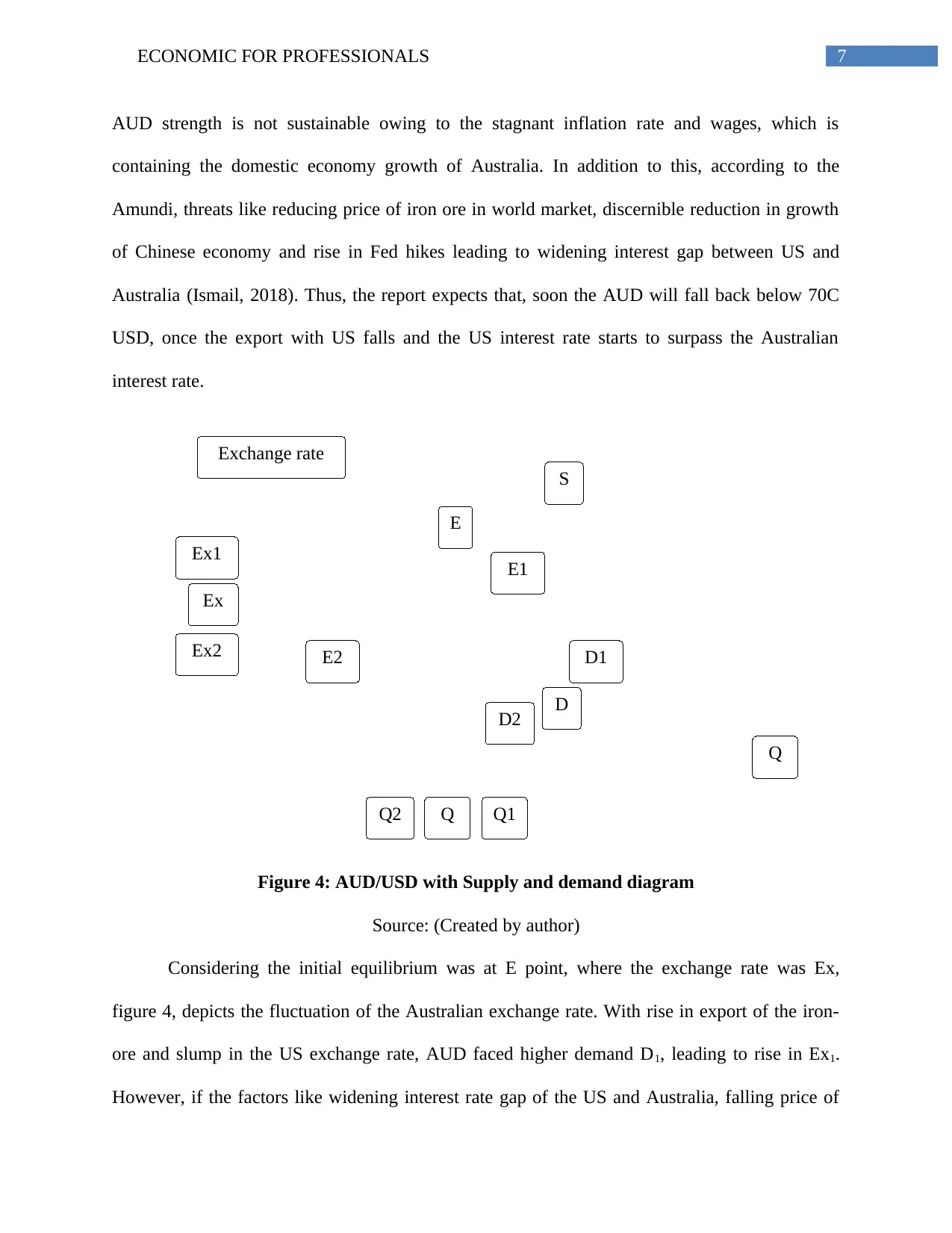
7ECONOMIC FOR PROFESSIONALS
Exchange rate
S
D1
D
D2
Q
Q2 Q Q1
E1
E2
E
Ex
Ex1
Ex2
AUD strength is not sustainable owing to the stagnant inflation rate and wages, which is
containing the domestic economy growth of Australia. In addition to this, according to the
Amundi, threats like reducing price of iron ore in world market, discernible reduction in growth
of Chinese economy and rise in Fed hikes leading to widening interest gap between US and
Australia (Ismail, 2018). Thus, the report expects that, soon the AUD will fall back below 70C
USD, once the export with US falls and the US interest rate starts to surpass the Australian
interest rate.
Figure 4: AUD/USD with Supply and demand diagram
Source: (Created by author)
Considering the initial equilibrium was at E point, where the exchange rate was Ex,
figure 4, depicts the fluctuation of the Australian exchange rate. With rise in export of the iron-
ore and slump in the US exchange rate, AUD faced higher demand D1, leading to rise in Ex1.
However, if the factors like widening interest rate gap of the US and Australia, falling price of
Exchange rate
S
D1
D
D2
Q
Q2 Q Q1
E1
E2
E
Ex
Ex1
Ex2
AUD strength is not sustainable owing to the stagnant inflation rate and wages, which is
containing the domestic economy growth of Australia. In addition to this, according to the
Amundi, threats like reducing price of iron ore in world market, discernible reduction in growth
of Chinese economy and rise in Fed hikes leading to widening interest gap between US and
Australia (Ismail, 2018). Thus, the report expects that, soon the AUD will fall back below 70C
USD, once the export with US falls and the US interest rate starts to surpass the Australian
interest rate.
Figure 4: AUD/USD with Supply and demand diagram
Source: (Created by author)
Considering the initial equilibrium was at E point, where the exchange rate was Ex,
figure 4, depicts the fluctuation of the Australian exchange rate. With rise in export of the iron-
ore and slump in the US exchange rate, AUD faced higher demand D1, leading to rise in Ex1.
However, if the factors like widening interest rate gap of the US and Australia, falling price of
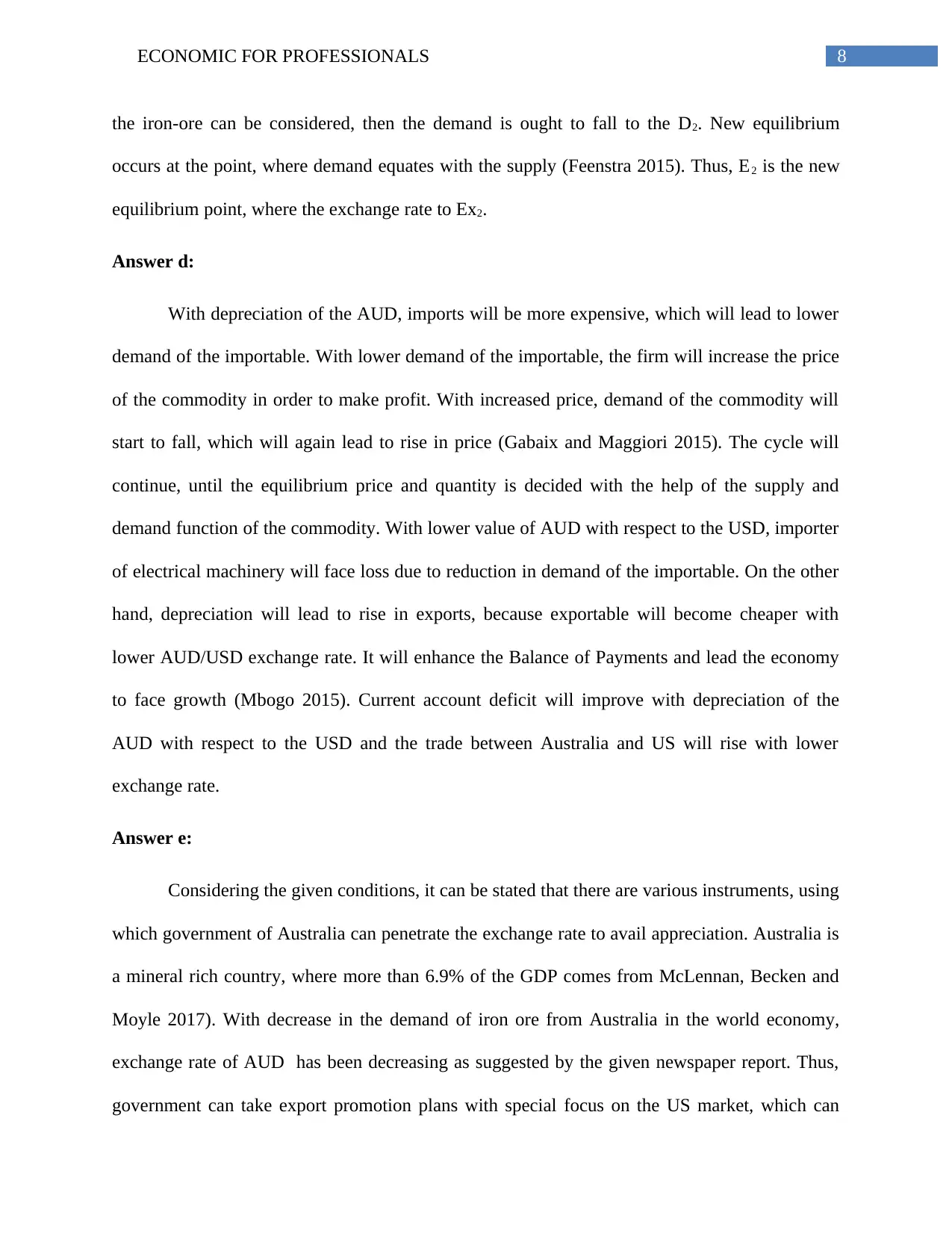
8ECONOMIC FOR PROFESSIONALS
the iron-ore can be considered, then the demand is ought to fall to the D2. New equilibrium
occurs at the point, where demand equates with the supply (Feenstra 2015). Thus, E2 is the new
equilibrium point, where the exchange rate to Ex2.
Answer d:
With depreciation of the AUD, imports will be more expensive, which will lead to lower
demand of the importable. With lower demand of the importable, the firm will increase the price
of the commodity in order to make profit. With increased price, demand of the commodity will
start to fall, which will again lead to rise in price (Gabaix and Maggiori 2015). The cycle will
continue, until the equilibrium price and quantity is decided with the help of the supply and
demand function of the commodity. With lower value of AUD with respect to the USD, importer
of electrical machinery will face loss due to reduction in demand of the importable. On the other
hand, depreciation will lead to rise in exports, because exportable will become cheaper with
lower AUD/USD exchange rate. It will enhance the Balance of Payments and lead the economy
to face growth (Mbogo 2015). Current account deficit will improve with depreciation of the
AUD with respect to the USD and the trade between Australia and US will rise with lower
exchange rate.
Answer e:
Considering the given conditions, it can be stated that there are various instruments, using
which government of Australia can penetrate the exchange rate to avail appreciation. Australia is
a mineral rich country, where more than 6.9% of the GDP comes from McLennan, Becken and
Moyle 2017). With decrease in the demand of iron ore from Australia in the world economy,
exchange rate of AUD has been decreasing as suggested by the given newspaper report. Thus,
government can take export promotion plans with special focus on the US market, which can
the iron-ore can be considered, then the demand is ought to fall to the D2. New equilibrium
occurs at the point, where demand equates with the supply (Feenstra 2015). Thus, E2 is the new
equilibrium point, where the exchange rate to Ex2.
Answer d:
With depreciation of the AUD, imports will be more expensive, which will lead to lower
demand of the importable. With lower demand of the importable, the firm will increase the price
of the commodity in order to make profit. With increased price, demand of the commodity will
start to fall, which will again lead to rise in price (Gabaix and Maggiori 2015). The cycle will
continue, until the equilibrium price and quantity is decided with the help of the supply and
demand function of the commodity. With lower value of AUD with respect to the USD, importer
of electrical machinery will face loss due to reduction in demand of the importable. On the other
hand, depreciation will lead to rise in exports, because exportable will become cheaper with
lower AUD/USD exchange rate. It will enhance the Balance of Payments and lead the economy
to face growth (Mbogo 2015). Current account deficit will improve with depreciation of the
AUD with respect to the USD and the trade between Australia and US will rise with lower
exchange rate.
Answer e:
Considering the given conditions, it can be stated that there are various instruments, using
which government of Australia can penetrate the exchange rate to avail appreciation. Australia is
a mineral rich country, where more than 6.9% of the GDP comes from McLennan, Becken and
Moyle 2017). With decrease in the demand of iron ore from Australia in the world economy,
exchange rate of AUD has been decreasing as suggested by the given newspaper report. Thus,
government can take export promotion plans with special focus on the US market, which can
⊘ This is a preview!⊘
Do you want full access?
Subscribe today to unlock all pages.

Trusted by 1+ million students worldwide

9ECONOMIC FOR PROFESSIONALS
increase the demand of the Australian mining goods, leading to rise in demand of the AUD in the
foreign countries (Groenewold 2017). It can efficiently appreciate the AUD with respect to the
USD. Besides this, the newspaper report has mentioned that there is widening gap between the
US interest rate and the Australian interest rate due to recent rise in the Fed rate. If the gap
widens largely, then most of the foreign investors will withdraw their investment from the
Australian economy and put it into the US economy. It will lead to fall in AUD exchange rate
and rise in USD exchange rate. Thus, Reserve Bank of Australia needs to take actions in order to
gauge the situation. With stagnant inflation and wage rate, domestic economy of Australia is
gradually slowing down (Bramble 2015). In order to overcome this situation, Australian Reserve
Bank need to rise their interest rate and government need to take fiscal expansion program from
the accumulated money. It will provide much needed boost to the economy to overcome the
stagnant inflation and wage rate situation. In addition to this, government can go for import
substitution and bring in quota system for importable in order to stop the net export deficit.
Though these plans are effective to bring back the AUD exchange rate from 72C to 80C
USD for each AUD, however it has various side effects. For instance, with rise in export
promotion, AUD can get appreciated, which will lead to rise in importable (Wang 2016). With
higher importable, net export will tend to fall and the economy will remain at same position.
Besides this, once the government rise interest rate, domestic investment will rise, however
demand will fall due to lack of liquidity in the market. Bringing in import quota is not possible in
presence of the AUSFTA pact between two countries.
Considering both the pros and cons, it can be stated that, Australia can bring back the
exchange rate to 80C USD for each AUD with the above mentioned plans, however, government
need to take care of the side effects with caution. Maintain balance between market liquidity and
increase the demand of the Australian mining goods, leading to rise in demand of the AUD in the
foreign countries (Groenewold 2017). It can efficiently appreciate the AUD with respect to the
USD. Besides this, the newspaper report has mentioned that there is widening gap between the
US interest rate and the Australian interest rate due to recent rise in the Fed rate. If the gap
widens largely, then most of the foreign investors will withdraw their investment from the
Australian economy and put it into the US economy. It will lead to fall in AUD exchange rate
and rise in USD exchange rate. Thus, Reserve Bank of Australia needs to take actions in order to
gauge the situation. With stagnant inflation and wage rate, domestic economy of Australia is
gradually slowing down (Bramble 2015). In order to overcome this situation, Australian Reserve
Bank need to rise their interest rate and government need to take fiscal expansion program from
the accumulated money. It will provide much needed boost to the economy to overcome the
stagnant inflation and wage rate situation. In addition to this, government can go for import
substitution and bring in quota system for importable in order to stop the net export deficit.
Though these plans are effective to bring back the AUD exchange rate from 72C to 80C
USD for each AUD, however it has various side effects. For instance, with rise in export
promotion, AUD can get appreciated, which will lead to rise in importable (Wang 2016). With
higher importable, net export will tend to fall and the economy will remain at same position.
Besides this, once the government rise interest rate, domestic investment will rise, however
demand will fall due to lack of liquidity in the market. Bringing in import quota is not possible in
presence of the AUSFTA pact between two countries.
Considering both the pros and cons, it can be stated that, Australia can bring back the
exchange rate to 80C USD for each AUD with the above mentioned plans, however, government
need to take care of the side effects with caution. Maintain balance between market liquidity and
Paraphrase This Document
Need a fresh take? Get an instant paraphrase of this document with our AI Paraphraser
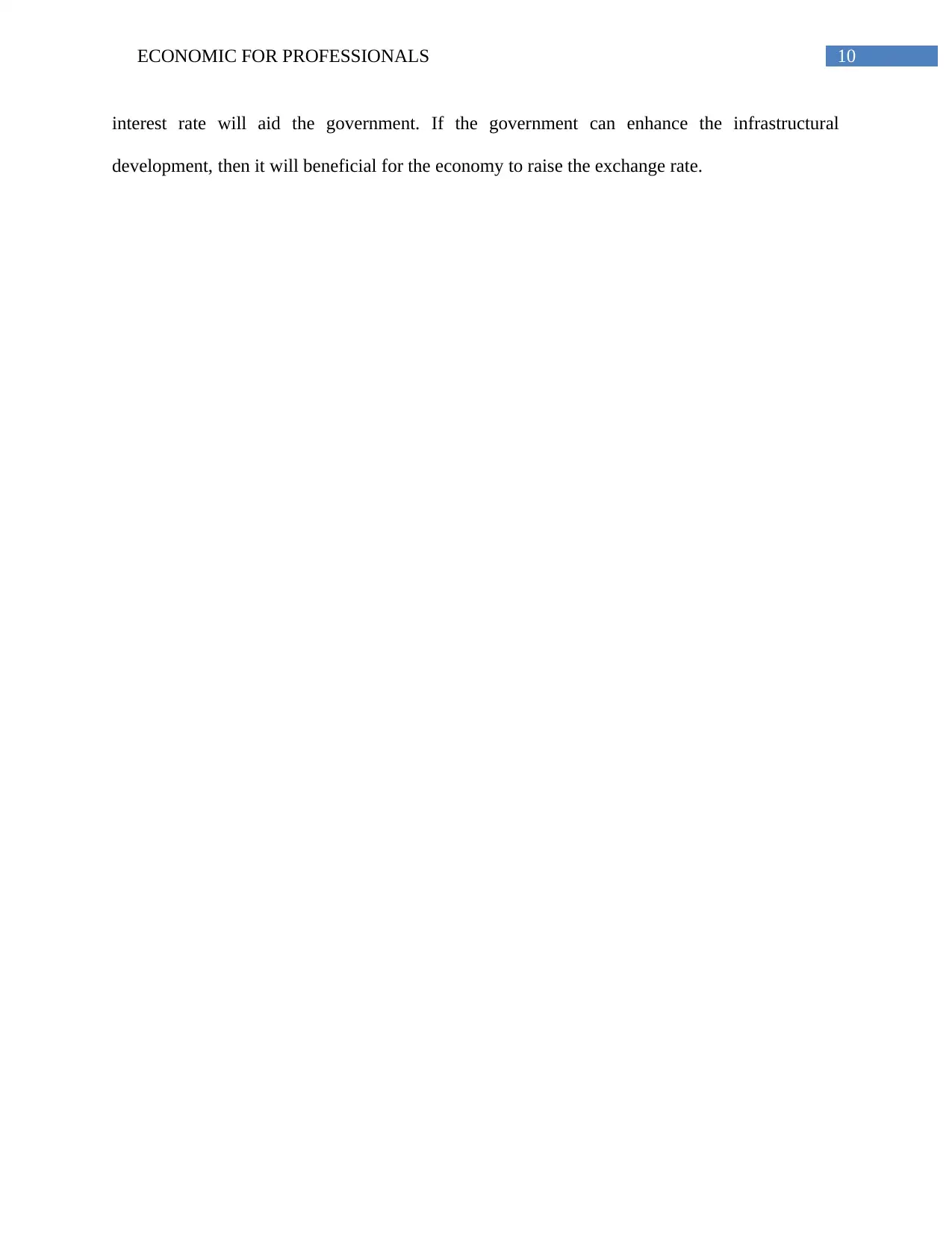
10ECONOMIC FOR PROFESSIONALS
interest rate will aid the government. If the government can enhance the infrastructural
development, then it will beneficial for the economy to raise the exchange rate.
interest rate will aid the government. If the government can enhance the infrastructural
development, then it will beneficial for the economy to raise the exchange rate.
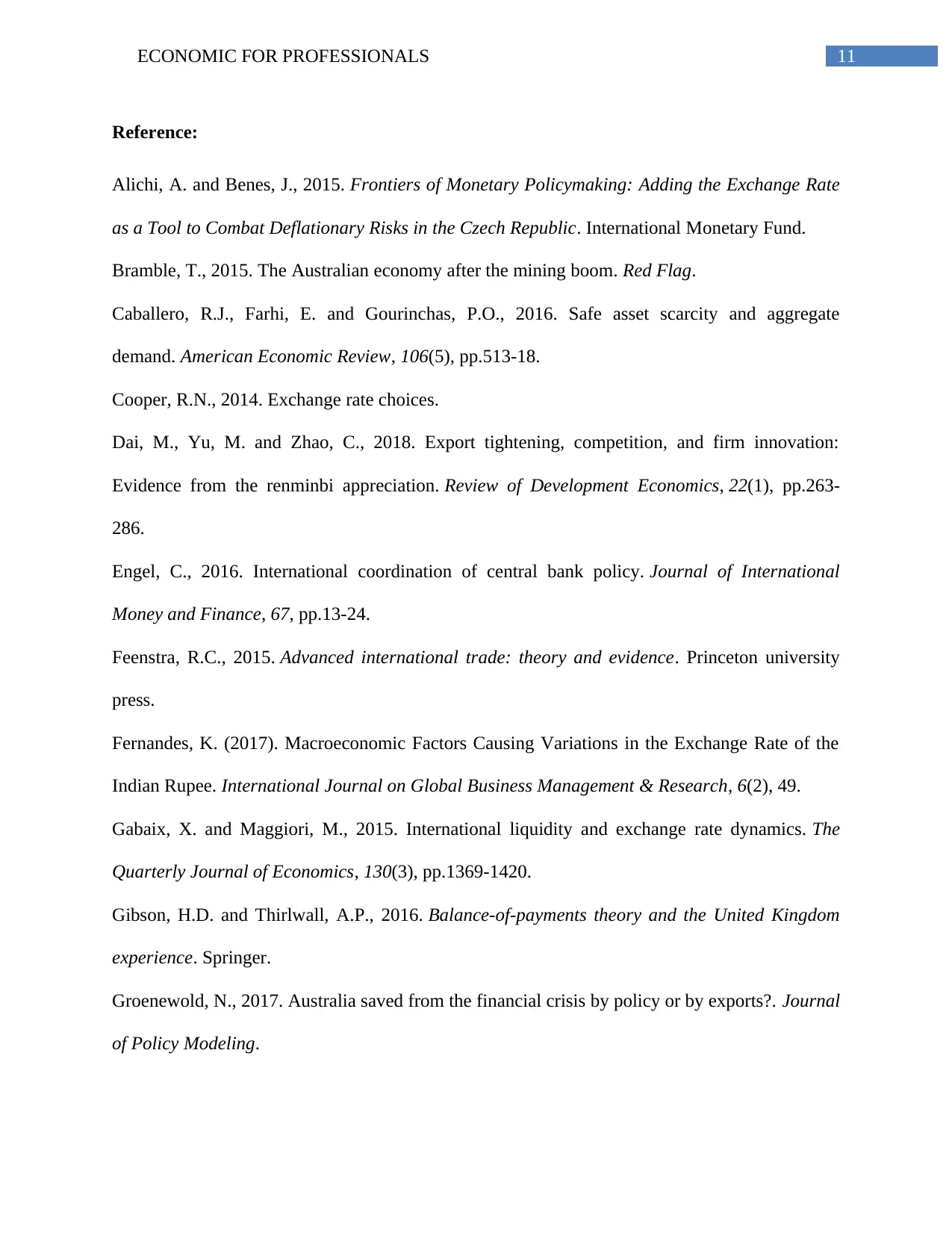
11ECONOMIC FOR PROFESSIONALS
Reference:
Alichi, A. and Benes, J., 2015. Frontiers of Monetary Policymaking: Adding the Exchange Rate
as a Tool to Combat Deflationary Risks in the Czech Republic. International Monetary Fund.
Bramble, T., 2015. The Australian economy after the mining boom. Red Flag.
Caballero, R.J., Farhi, E. and Gourinchas, P.O., 2016. Safe asset scarcity and aggregate
demand. American Economic Review, 106(5), pp.513-18.
Cooper, R.N., 2014. Exchange rate choices.
Dai, M., Yu, M. and Zhao, C., 2018. Export tightening, competition, and firm innovation:
Evidence from the renminbi appreciation. Review of Development Economics, 22(1), pp.263-
286.
Engel, C., 2016. International coordination of central bank policy. Journal of International
Money and Finance, 67, pp.13-24.
Feenstra, R.C., 2015. Advanced international trade: theory and evidence. Princeton university
press.
Fernandes, K. (2017). Macroeconomic Factors Causing Variations in the Exchange Rate of the
Indian Rupee. International Journal on Global Business Management & Research, 6(2), 49.
Gabaix, X. and Maggiori, M., 2015. International liquidity and exchange rate dynamics. The
Quarterly Journal of Economics, 130(3), pp.1369-1420.
Gibson, H.D. and Thirlwall, A.P., 2016. Balance-of-payments theory and the United Kingdom
experience. Springer.
Groenewold, N., 2017. Australia saved from the financial crisis by policy or by exports?. Journal
of Policy Modeling.
Reference:
Alichi, A. and Benes, J., 2015. Frontiers of Monetary Policymaking: Adding the Exchange Rate
as a Tool to Combat Deflationary Risks in the Czech Republic. International Monetary Fund.
Bramble, T., 2015. The Australian economy after the mining boom. Red Flag.
Caballero, R.J., Farhi, E. and Gourinchas, P.O., 2016. Safe asset scarcity and aggregate
demand. American Economic Review, 106(5), pp.513-18.
Cooper, R.N., 2014. Exchange rate choices.
Dai, M., Yu, M. and Zhao, C., 2018. Export tightening, competition, and firm innovation:
Evidence from the renminbi appreciation. Review of Development Economics, 22(1), pp.263-
286.
Engel, C., 2016. International coordination of central bank policy. Journal of International
Money and Finance, 67, pp.13-24.
Feenstra, R.C., 2015. Advanced international trade: theory and evidence. Princeton university
press.
Fernandes, K. (2017). Macroeconomic Factors Causing Variations in the Exchange Rate of the
Indian Rupee. International Journal on Global Business Management & Research, 6(2), 49.
Gabaix, X. and Maggiori, M., 2015. International liquidity and exchange rate dynamics. The
Quarterly Journal of Economics, 130(3), pp.1369-1420.
Gibson, H.D. and Thirlwall, A.P., 2016. Balance-of-payments theory and the United Kingdom
experience. Springer.
Groenewold, N., 2017. Australia saved from the financial crisis by policy or by exports?. Journal
of Policy Modeling.
⊘ This is a preview!⊘
Do you want full access?
Subscribe today to unlock all pages.

Trusted by 1+ million students worldwide
1 out of 13
Related Documents
Your All-in-One AI-Powered Toolkit for Academic Success.
+13062052269
info@desklib.com
Available 24*7 on WhatsApp / Email
![[object Object]](/_next/static/media/star-bottom.7253800d.svg)
Unlock your academic potential
Copyright © 2020–2025 A2Z Services. All Rights Reserved. Developed and managed by ZUCOL.





